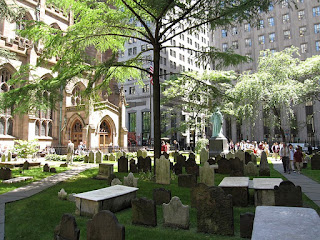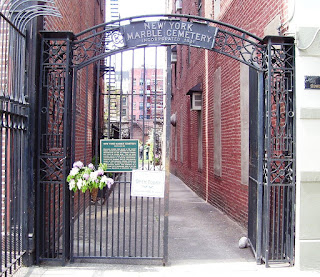American Plague: How Yellow Fever Epidemics in the 19th Century led to New York City's Two Strangest Cemeteries
There are no headstones.
A narrow wrought iron gate off of 2nd Avenue opens and leads into a confined and claustrophobic alleyway. This spot is barely visible from the sidewalk and most pedestrians walk by without giving the place even so much as a second glance.
The alleyway ends in a small grassy clearing that is only a half acre wide and enclosed by stone walls on all sides. This is the New York Marble Cemetery and it is one of the smallest, most obscure and oddest burial grounds in all of America’s largest city.
At one time the official address of the New York Marble Cemetery was 41 and a half 2nd Avenue. Just a few blocks over, there is another cemetery almost exactly like this one, though slightly less well hidden from public view, called the New York City Marble Cemetery.
These two cemeteries were opened in 1830 and 1831, respectively, at a time when burial underground in coffins was banned out of fear of contracting a disease by coming in contact with infected peoples or soil. In 1830 New York City was in the grips of a terrifying and recurrent yellow fever epidemic.
 |
| Inside the New York Marble Cemetery |
As a result of the yellow fever outbreak of 1830, particularly in response to the high number of cases and deaths reported in the vicinity of Holy Trinity Church on the Upper West Side of Manhattan which contained the city’s largest burial site where almost all of New York’s Roman Catholics were then interred, New York City lawmakers had banned earthen burials. At that time, leaders and lawmakers operated under the mistaken belief that disease could be spread from one person to another, or even from neighborhood to neighborhood, through contaminated air or soil.
That summer yellow fever had decimated the city’s burgeoning and poverty stricken Roman Catholic population. Deaths among New York’s Catholics, many of whom had only recently immigrated from Ireland and tended to live in the city’s poorest and most crowded neighborhoods, ran as high as fifteen percent of the total Catholic population! Yellow fever is a virus that is caused by mosquito bites. Within a week of being bitten a person stricken with yellow fever will begin to develop a high temperature, body aches and chills.
 |
| One of the Burial Sites at Holy Trinity |
Back in 1830, decades before a vaccine for the disease was developed and at a time when many were undernourished, often death would occur within 3 to 4 days after the onset of symptoms.
New York City in 1830, like the rest of the United States, was no stranger to the scourge of yellow fever. During the American Revolution yellow fever was called the Pox Americana, as it repeatedly swept through both the British and American armies, and literally killed more soldiers on both sides than combat.
The most shocking outbreak of yellow fever occurred only a few years after the Constitutional Convention during the oppressively hot summer of 1793 in Philadelphia.
In 1793 it is believed that yellow fever killed 5000 Philadelphians out of a total population of just under 50,000 citizens. The 1793 epidemic spread from Philadelphia across the nation and was greatly feared by many prominent Americans at the time. Each summer yellow fever would come back to America’s cities and kill again and again for decades.
One witness to the Philadelphia epidemic of 1793 reported that, “acquaintances and friends avoided each other in the streets...the old custom of shaking hands fell into such disuse that many were affronted at even the offering of a hand.”
It would not be until the turn of the 20th century that it would be confirmed that yellow fever was transmitted through mosquito bites only and not through person to person contact as many believed during the 18th and 19th centuries.
 |
| Yellow Fever Epidemic |
Each summer it seemed to many as if the disease came to America like a plague from God. Secretary of War Henry Knox wrote to President Washington that, “the alarm of the people in all the towns and villages on the roads into New York is inexpressible.”
Outbreaks of the disease would visit New York City in 1793, 1795, 1803 and then again in 1830 with avengence.
By 1830 people were willing to try anything to prevent the spread of yellow fever and the Marble Cemeteries were born.
The first of these was the New York Marble Cemetery which was first opened in 1830 at the height of that year’s outbreak of yellow fever. The Marble Cemetery contained 156 marble vaults, each the size of a small room, buried a full ten feet underground. Each marble vault would be marked by a marble slab in lieu of a headstone and the New York Marble Cemetery would be the first non-sectarian burial ground in all of New York City.
Of course, out of fear, not wishing to be lumped in with what they considered to be Roman Catholic Irish riff-raff who seemed to be more prone to yellow fever, anyway, the New York Marble Cemetery and the New York City Marble Cemetery vaults were reserved solely for the city’s elite and most well-to-do merchants and aristocratic families.
The New York Marble Cemetery was in active operation between 1830 and 1937. In that 107 year timespan around 2,000 burials would take place at the half acre site. The first burial in August of 1830 was of a child, probably the victim of yellow fever, of someone whose name is recorded as Dr. Post. The last burial at the New York Marble Cemetery of Charles Janeway VanZandt occurred in 1937.
Most of the burials that occurred in the vaults in the 1830’s, more than half, appear to be those of children whose immune systems are less developed than those of adults and would very likely have been more prone to succumb to death as a result of yellow fever.
Interestingly, today the New York Marble Cemetery is still open to visitors. At least, prior to the start of the COVID 19 pandemic in March of 2020, visitors could tour the cemetery every Sunday between the month of April and October.
Originally, each marble slab could be moved and then visitors could descend down a staircase ten feet underground to actually go into the individual marble vaults beneath the earth. Unfortunately, most of the keys to the vaults in the New York Marble Cemetery have been lost, and most of the locking mechanisms are no longer operable or have corroded away with time and the tombs remained sealed. For now, at least, the marble slabs will have to rest where they lay.
In 1969 the New York Marble Cemetery and its brother cemetery the New York City Marble Cemetery were deemed National Historic Landmarks worthy of preservation, and it is no longer considered safe for any visitors to enter the actual burial vaults.
 |
| The New York City Marble Cemetery |
The marble to create the vaults in the New York Marble Cemetery was mined locally just outside the town of Tuckahoe in Westchester County only several miles north of Manhattan. Today, efforts are ongoing to preserve the marble in the cemetery for future generations and, believe it or not, the grassy gardened area of the cemetery can be rented out for weddings and other private parties with all proceeds going to preservation and restoration efforts at the New York Marble Cemetery.
After the 1830’s, with an influx of population thanks to the rise in immigration driven by the ever expanding industrial revolution in America and the rapidly growing need for cheap labor in the northeast, many affluent families sought to have their final resting place in more pastoral and bucolic cemeteries outside of the confines of the city.
By the end of the American Civil War urban cemeteries fell out of favor with all except the destitute and very poor. Those who could afford to do so had their families interred in more peaceful surroundings in more parklike settings in what today would be called the suburbs. Though internments would continue sporadically at the New York Marble Cemetery until 1937, its era as the final resting place for many of New York’s most affluent citizens and socialites would be all but over by the turn of the 20th century.
America would suffer its last major yellow fever outbreak in 1905 in New Orleans, Louisiana. Unlike other diseases, which often require a vaccine to be created in order to be eradicated, yellow fever was able to be contained and nearly eliminated prior to 1920 through the effective use of insecticides and insect repellents. Once it was discovered, and agreed upon, that yellow fever was spread through bites from infected mosquitoes (hence the reason all of New York City and Philadelphia’s outbreaks occurred in July and August) then it was only a matter of time before cities launched concerted efforts to tamp down their mosquito populations.
Today, unfortunately though despite the development of a vaccine, yellow fever continues to ravage many of the world’s poorer nations that are located in tropical and subtropical climates, and even more tragically, the disease does still pop up from time to time in the United States.
Though the constant specter of yellow fever no longer hangs over the American people like a plague as it once did, the New York Marble Cemetery still stands behind an iron gate and down a narrow alleyway as it has for nearly 200 hundred years now, and given the state of our world today it is definitely worth more than a passing glance from all those who walk by it each day on 2nd Avenue.




Comments
Post a Comment